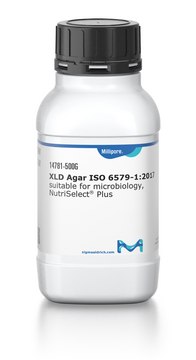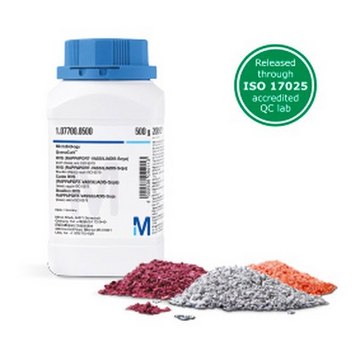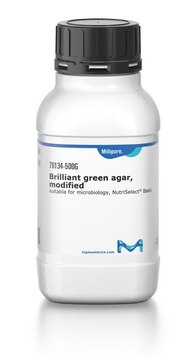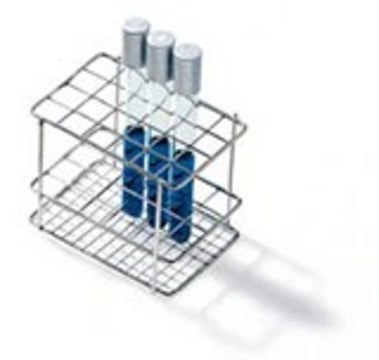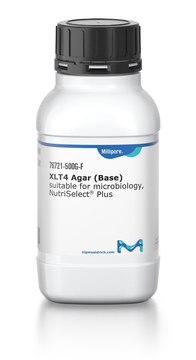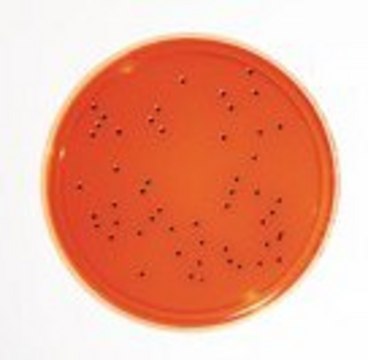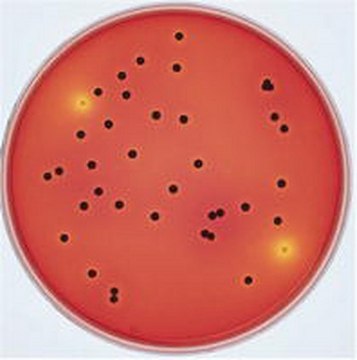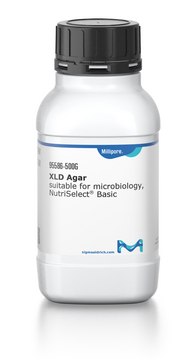95586
XLD Agar
suitable for microbiology, NutriSelect® Basic
Synonym(s):
Xylose Lysine Deoxycholate Agar
Select a Size
Select a Size
About This Item
Recommended Products
sterility
non-sterile
Quality Level
form
powder
shelf life
limited shelf life, expiry date on the label
composition
agar, 15 g/L
ammonium ferric citrate, 0.8 g/L
lactose, 7.5 g/L
L-lysine hydrochloride, 5 g/L
phenol red, 0.08 g/L
sodium chloride, 5 g/L
sodium deoxycholate, 2.5 g/L
sodium thiosulfate, 6.8 g/L
sucrose, 7.5 g/L
xylose, 3.5 g/L
yeast extract, 3 g/L
manufacturer/tradename
NutriSelect® Basic
technique(s)
microbiological culture: suitable
final pH
7.4±0.2 (25 °C)
application(s)
environmental
food and beverages
veterinary
microbiology
suitability
selective and differential for Klebsiella spp.
selective and differential for Proteus spp.
selective and differential for Salmonella spp.
selective and differential for Shigella spp.
selective and differential for enterobacteriaceae
1 of 4
This Item | 76721 | 14781 | 70135 |
|---|---|---|---|
| suitability selective and differential for Klebsiella spp., selective and differential for Salmonella spp., selective and differential for enterobacteriaceae, selective and differential for Proteus spp., selective and differential for Shigella spp. | suitability selective and differential for Citrobacter spp., selective and differential for Escherichia coli, selective and differential for Salmonella spp., selective and differential for Shigella spp., selective and differential for coliforms, selective and differential for enterobacteriaceae | suitability Salmonella spp. | suitability selective and differential for Salmonella spp., selective and differential for Shigella spp., selective and differential for Vibrio spp., selective and differential for Yersinia spp. |
| technique(s) microbiological culture: suitable | technique(s) microbiological culture: suitable | technique(s) - | technique(s) microbiological culture: suitable |
| sterility non-sterile | sterility non-sterile | sterility non-sterile | sterility - |
| composition agar, 15 g/L , lactose, 7.5 g/L , phenol red, 0.08 g/L , sodium deoxycholate, 2.5 g/L , sucrose, 7.5 g/L , yeast extract, 3 g/L , ammonium ferric citrate, 0.8 g/L , sodium chloride, 5 g/L , xylose, 3.5 g/L , L-lysine hydrochloride, 5 g/L , sodium thiosulfate, 6.8 g/L | composition agar, 18 g/L , ammonium-iron(III) citrate, 0.8 g/L , lactose, 7.5 g/L , L-lysine, 5 g/L , phenol-red, 0.08 g/L , proteose peptone No. 3, 1.6 g/L , sodium chloride, 5 g/L , sodium thiosulfate, 6.8 g/L , sucrose, 7.5 g/L , xylose, 3.75 g/L , yeast extract, 3 g/L | composition agar, 15.0 g/L , ferric ammonium citrate, 0.80 g/L , lactose, 7.5 g/L , L-lysine hydrochloride, 5.0 g/L , phenol red, 0.08 g/L , sodium chloride, 5.0 g/L , sodium deoxycholate, 1.0 g/L , sodium thiosulfate, 6.8 g/L , sucrose, 7.5 g/L , xylose, 3.75 g/L , yeast extract, 3.0 g/L | composition agar, 12.0 g/L , lactose, 5.0 g/L , neutral red, 0.03 g/L , sodium citrate, 10.5 g/L , sodium desoxycholate, 2.5 g/L , sodium thiosulfate, 5.0 g/L , special peptone, 10.0 g/L , sucrose, 5.0 g/L |
| application(s) environmental | application(s) clinical testing | application(s) food and beverages | application(s) clinical testing |
Application
Preparation Note
Footnote
The designations basic, plus, or prime are added to indicate the quality control level, from basic quality control to standard QC plus to prime for full regulatory compliance.
Legal Information
Storage Class Code
11 - Combustible Solids
WGK
WGK 2
Flash Point(F)
Not applicable
Flash Point(C)
Not applicable
Personal Protective Equipment
Regulatory Information
Choose from one of the most recent versions:
Already Own This Product?
Find documentation for the products that you have recently purchased in the Document Library.
Articles
Salmonella, with 2,300+ serotypes, causes half of food-borne illnesses, often from dairy, poultry, and eggs.
Our team of scientists has experience in all areas of research including Life Science, Material Science, Chemical Synthesis, Chromatography, Analytical and many others.
Contact Technical Service